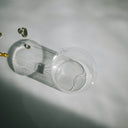Hair gel is a staple in many grooming routines, offering hold, shine, and versatility for styles ranging from sleek looks to spiked textures. But as with any product applied regularly to the scalp, concerns about its long-term effects on hair health linger. Among the most pressing questions: Could your daily gel habit be contributing to thinning or bald spots? This article separates fact from fiction, exploring how hair gel interacts with your strands and scalp—and when it might play a role in hair loss.
Table of content
Can Hair Gel Cause Hair Loss?
Hair gel does not directly cause hair loss, but certain ingredients and styling habits linked to its use can contribute to thinning or breakage over time. Issues arise from alcohol-based formulas that dry out hair, aggressive application/removal causing traction stress, or clogged follicles from product buildup. However, with mindful product choices and gentle styling practices, most users can avoid these risks.
As your leading source for hair health information over the past 4 years, we never compromise on accuracy. When it comes to your health, you deserve information you can truly rely on - and earning your trust is our top priority.
Here's how Scandinavian Biolabs ensures every piece of content meets the highest standards of accuracy and integrity:
- Credentialed Experts: Our reviewers are actively practicing doctors and medical researchers
- Stringent Reviews: Content undergoes rigorous editing by subject specialists and review by a practicing doctor.
- Evidence-Based: We rely on well-established research from trusted scientific sources like peer-reviewed journals and health authorities.
- Full Transparency: Our editorial standards, writer credentials, reviewer credentials, correction process, and funding are all publicly documented.
- Independent Voice: While we do promote products, we operate in a vacuum to business operations. Our main goal is just an unwavering commitment to providing medically-sound guidance.
You can count on Scandinavian Biolabs to consistently deliver the trustworthy health information you deserve. Read our Editorial Standards.
How Hair Gel Works: Types and Ingredients
Common Types of Hair Gel
- Alcohol-Based Gels: Provide strong hold but can dehydrate hair and scalp.
- Alcohol-Free Gels: Use humectants like glycerin; gentler but less hold.
- Natural/Organic Gels: Often contain aloe vera or flaxseed; minimal chemicals.
- Medicated Gels: Include ingredients like ketoconazole for dandruff-prone scalps.
Key Ingredients to Watch
- SD Alcohol 40 or Ethanol: Drying alcohols that weaken hair shafts.
- Parabens/Sulfates: Preservatives that may irritate sensitive scalps.
- Polyvinylpyrrolidone (PVP): A polymer that can cause flaking and buildup.
How Hair Gel May Contribute to Hair Loss
1. Traction Alopecia from Tight Styling
Repeatedly pulling hair into tight styles (e.g., slicked-back ponytails, hard parts) with gel strains follicles. Over time, this tension can lead to:
- Receding hairlines or thinning around the temples
- Broken hairs along the part line
A 2020 study in Skin Appendage Disorders found traction alopecia in 31% of people who frequently used stiff-hold styling products.
2. Dryness and Breakage
Alcohol-based gels strip natural oils, leaving hair brittle and prone to snapping. Signs include:
- Split ends
- “Halo” of broken hairs around the crown
- Frizz despite product use
3. Follicle Clogging and Scalp Inflammation
Failing to wash out gel thoroughly can clog pores with:
- Sebum buildup: Mixes with gel residue, blocking follicles.
- Dandruff flare-ups: Irritation from drying alcohols or fragrances.
Chronic inflammation may disrupt the hair growth cycle, leading to diffuse thinning.
4. Chemical Damage to Hair Shafts
Harsh solvents in gels (e.g., propylene glycol) degrade the hair’s cuticle layer, causing:
- Loss of elasticity
- Increased porosity (fading color, moisture loss)
Signs Your Hair Gel Is Harming Your Hair
Watch for these red flags:
- Scalp itching or redness after application
- Hair feeling straw-like or gummy
- Increased shedding during washing/combing
- Visible flakes or residue at the roots
How to Use Hair Gel Safely
1. Choose the Right Formula
- For Daily Use: Alcohol-free gels with moisturizers (panthenol, argan oil).
- For Strong Hold: Opt for water-based gels over alcohol-heavy ones.
- Sensitive Scalps: Fragrance-free, hypoallergenic options.
2. Apply Mindfully
- Avoid Roots: Apply gel mid-lengths to ends to prevent scalp buildup.
- Use a Wide-Tooth Comb: Distribute product gently without tugging.
- Skip Tight Styles Daily: Reserve slicked-back looks for special occasions.
3. Wash Thoroughly
- Use a clarifying shampoo 1–2x weekly to remove residue.
- Double cleanse if using heavy-hold gels.
- Follow with a hydrating conditioner.
4. Nourish Your Scalp
- Massage with rosemary oil 2x weekly to boost circulation.
- Exfoliate with a salicylic acid scalp scrub monthly.
Alternatives to Traditional Hair Gels
For those prone to hair loss, consider these gentler options:
- Hair Creams: Lightweight moisture without crunch (e.g., shea butter-based).
- Sea Salt Spray: Adds texture without alcohol.
- Aloe Vera Gel: Natural hold + scalp soothing.
Debunking Myths About Hair Gel and Hair Loss
Myth 1: “All Gels Cause Baldness”
Truth: Genetics (androgenetic alopecia) and hormones are the primary drivers of baldness. Gel misuse may exacerbate thinning but isn’t a root cause.
Myth 2: “Gel Makes Hair Fall Out from the Root”
Truth: Gel-related hair loss typically involves breakage, not follicle death. Telogen effluvium (stress shedding) from scalp irritation is reversible.
Myth 3: “Organic Gels Are Always Safe”
Truth: Even natural gels can cause buildup or allergic reactions. Patch-test new products.
When to See a Dermatologist
Consult a specialist if you experience:
- Bald patches or sudden shedding
- Burning/scabbing on the scalp
- No improvement after switching products
Key Takeaways
- Hair gel isn’t a direct cause of hair loss but can contribute via breakage, tension, or scalp issues.
- Alcohol-free formulas and gentle styling reduce risks significantly.
- Persistent shedding likely signals an underlying condition needing medical evaluation.
Conclusion
While hair gel isn’t inherently harmful, its misuse can tip the scales toward damage. The key lies in balancing style with scalp health: choosing nourishing formulas, avoiding tension, and maintaining a clean, hydrated base. By rethinking how—and how often—you reach for that tub of gel, you can keep your hair both stylish and strong for years to come.
Tired of Thinning Hair? Try a Clinically Tested Serum.
Looking for a natural way to regrow hair and achieve a thicker, fuller head of hair? Ditch the stinging nettle for hair loss – Bio-Pilixin Serum is a drug-free hair activation serum that delivers clinically tested results.
Here's why Bio-Pilixin is superior:
- Clinically Tested Results: 93% of users saw a reduction in hair loss, and 73% experienced increased hair density.
- Safe and Natural: Unlike harsh chemicals, Bio-Pilixin uses plant growth factors derived from stem cell technology to nourish hair follicles and stimulate growth.
- Fast-Acting: See visible results in as little as 45 days (most typically see results within 150 days).
Stop wasting time on unproven remedies. Bio-Pilixin is the safe, natural serum you've been searching for.
Read more:






